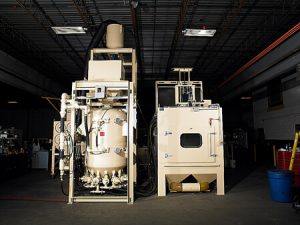If you’re working in metal fabrication, automotive restoration, or industrial maintenance, chances are you’ve come across sand blasting cabinets. They’re standard sandblasting equipment for surface prep—cleaning, stripping, or finishing a wide range of materials. But if you’re evaluating systems or training new operators, it’s worth understanding how a sand blasting cabinet works and what factors actually affect performance.
The Function and Purpose of a Sandblasting Cabinet
At its core, a sand blasting cabinet is a closed-loop system designed to direct abrasive media at a surface under pressure while keeping everything contained. The goal is simple: clean or texture the surface without exposing the surrounding workspace to dust or flying debris.

The cabinet allows for better media control, more consistent results, and a safer environment—especially when working with small to mid-size parts on a regular basis. These systems are commonly used to remove rust, paint, scale, or residue from metals, plastics, and composites, and to prepare surfaces for coating, bonding, or inspection.
Key Components That Make It Work
A quality blasting cabinet typically includes:
- A sealed enclosure that contains the process and reduces airborne contaminants.
- A blast gun, powered by compressed air, that accelerates abrasive media toward the surface.
- Integrated gloves and a viewing window, giving the operator full control over positioning and targeting.
- A dust collection system to keep the workspace visible and reduce cleanup.
- Media recovery, whether manual or automated, to reclaim and reuse suitable abrasives.
Most cabinets also feature a grated work surface or turntable to hold parts in place and allow spent media to fall through for collection.
Why Performance Varies Between Systems
Not all sand blasting cabinets are created equal. Differences in construction, airflow design, filtration, and ergonomics can dramatically affect usability and results. Some systems are built for occasional use, others for high-throughput industrial environments.
It’s not just about specs—it’s about how the components work together. That’s why it’s helpful to work with a supplier who understands the demands of real-world applications and can recommend the right combination of cabinet, media, and air supply.
Choosing a System That Matches Your Needs
Before selecting a cabinet, consider:
- The size and weight of your typical workpieces
- The type of media you plan to use
- Air compressor compatibility
- Frequency of use
- Level of precision or finish required
If you’re blasting delicate surfaces, you’ll need a different setup than if you’re stripping rust from steel brackets all day. And if you’re unsure where to start, it’s worth speaking with someone who handles these decisions regularly.
Find the Best Sand Blasting Cabinet at N.T. Ruddock
A sand blasting cabinet is a straightforward tool—but only when it’s the right tool, set up correctly. Understanding how it works is step one. Matching it to your application is where it really starts to deliver value.
If you’re weighing your options or looking to upgrade, get in touch. The right recommendation can save time, reduce material waste, and give you better results across the board.


